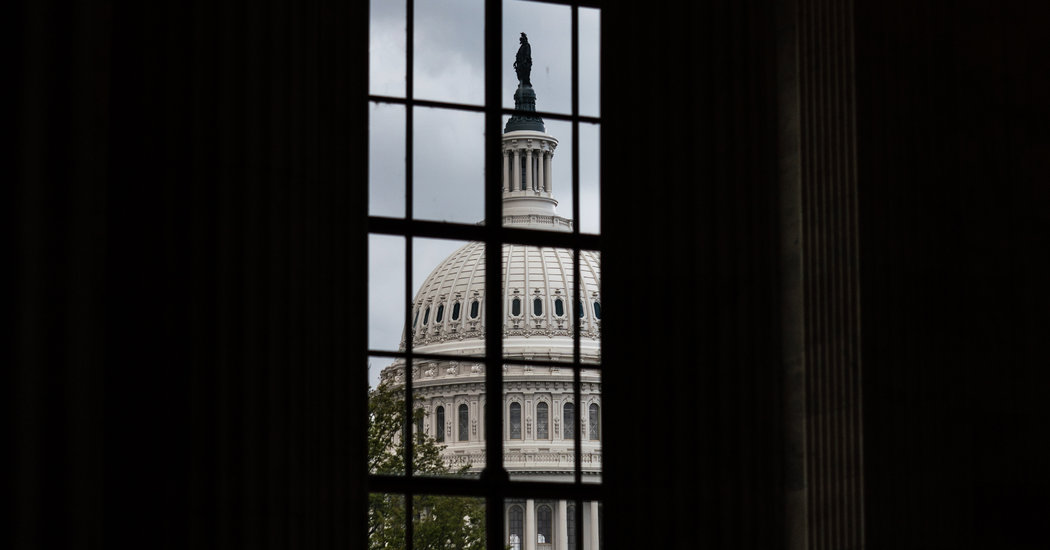Before the coronavirus crisis gets better, it will get worse: more death, more economic pain — and therefore more need for Congress to adopt relief measures for the American people.
But what if the pandemic reaches the point where lawmakers are simply unable to reconvene in Washington because of a complete shutdown of travel? What if the capital region becomes so inundated with illness that it makes return too risky? What if members return and start falling ill, setting off a domino effect? Already, six lawmakers are known to have come down with Covid-19. Especially in the Senate, where nearly half the members are age 65 or older, the potential for disaster is high.
Hypotheticals aside, it makes no sense for hundreds of lawmakers and aides to be zipping across the country as travel restrictions are tightened and Americans are ordered not to leave their homes. At what point does it become unacceptably dangerous, from a public-health and a public-duty perspective, for Congress to assemble in person during a pandemic?
These sorts of questions have been driving a growing number of lawmakers to agitate for an emergency system of remote voting. With the rest of America struggling to adapt to the new reality of social distancing, it is time for Congress to get serious about the issue.
On March 23, as the Coronavirus Aid, Relief, and Economic Security Act was being hammered out, 67 House Democrats asked the House Rules Committee to issue a temporary rule change enabling members to vote remotely during an emergency. This would not only reduce the risk of contagion, they argued, but it also would allow lawmakers already in quarantine to participate. Their letter came four days after Senator Rob Portman, Republican of Ohio, and Senator Dick Durbin, Democrat of Illinois, introduced a resolution calling for such a system in the upper chamber.
“In times of a national emergency, the Senate must be able to convene and act expeditiously even if we can’t be together in person,” Mr. Portman said, announcing the measure.
But both Speaker Nancy Pelosi and Mitch McConnell, the Senate majority leader, have rejected the idea. “That’s one of the few things that the speaker of the House and I agree on,” Mr. McConnell said in a March 31 interview with Fox News Radio.
Ms. Pelosi has expressed operational and constitutional concerns about setting up such a system, while Mr. McConnell maintains that there is no need to upend the way the Senate has operated for the past two centuries.
Under pressure from her members, last month Ms. Pelosi asked the chairman of the House Rules Committee to study the issue. A March 23 report by the committee’s majority staff laid out a number of potential challenges to remote voting. Most of them boiled down to: Change is hard.
Objections typically fall into a handful of categories.
Logistics. How would a remote system of debate and voting work? How would members register their votes? How could you make sure lawmakers were not under duress during voting? Advocates of remote voting acknowledge that many details would need to be hammered out but stress that such challenges aren’t insurmountable.
Technology and security. Citing both hacking and the potential for glitches, skeptics warn of the unreliability of a remote system. Robust protections would of course need to be adopted. The necessary pieces of the technology already exist, industry experts say, even if it would take time (and money) to build and battle-test a robust system.
Constitutionality. While there is some discussion about whether constitutional references to “meeting” and “attendance” could be interpreted to require lawmakers to conduct business in person, many constitutional scholars have noted that the founding fathers explicitly left it up to each chamber to “determine the rules of its proceedings.”
The slippery slope. Traditionalists fear that once you make it possible for lawmakers to conduct vital business remotely, it will be hard to herd them back to the Capitol, eroding the deliberative nature of legislating.
In the regular course of affairs, face-to-face negotiations and floor debates are indeed valuable. What is under discussion now is how to keep Congress functioning in extremely irregular conditions, when close interaction could prove dangerous for members and the public. The resolution from Mr. Portman and Mr. Durbin requires lawmakers to reauthorize any emergency voting system every 30 days.
Already, state legislatures have begun grappling with the issue. Pennsylvania lawmakers were early adopters. In late March, both chambers held sessions in which a majority of members voted remotely.
The shortcomings of some of the less dramatic alternatives that the Rules Committee cited, such as passing legislation by unanimous consent or a voice vote — neither of which requires members to gather on the House floor — were on display during the passage of the phase-three relief package. A lone Republican, Thomas Massie of Kentucky, blew up the process by demanding a roll-call vote. This forced scores of his colleagues to put their lives at risk to return to Washington and pile into the House chamber to override his petty stunt. Three days later, one of those members, Nydia Velázquez, Democrat of New York, announced that she had received a diagnosis of a “presumed coronavirus infection.”
There has to be a better, safer way for Congress to conduct the people’s business under extraordinary conditions.
The Times is committed to publishing a diversity of letters to the editor. We’d like to hear what you think about this or any of our articles. Here are some tips. And here’s our email: [email protected].
Follow The New York Times Opinion section on Facebook, Twitter (@NYTopinion) and Instagram.



















